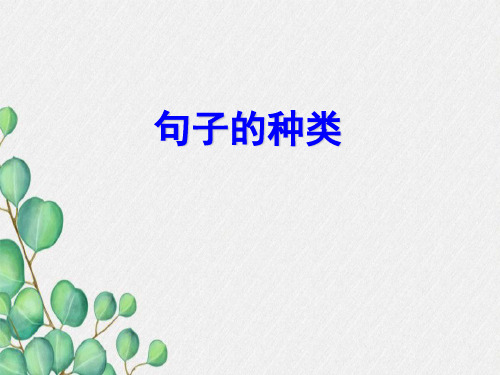英语句子种类65409
- 格式:pptx
- 大小:1.92 MB
- 文档页数:42

三句子的种类句子是一个独立的语言单位,表示一个完整的思想.按使用目的可分为陈述句、感叹句、疑问句和祈使句;从结构上又可分为简单句、并列句和复合句.按使用目的分:一、陈述句That boy always helps others.Tom was not at home yesterday.He is too late to catch the bus.二、疑问句一般疑问句、特殊疑问句、选择疑问句和反意疑问句Are you a doctorHow often do you have an English partyWhich would you like better, tea or coffeeShe is too young to go to school, is she三、感叹句(一)What +a /an+形容词+可数名词的单数形式+主语+谓语 ==二How+形容词+a/an +可数名词的单数形式+主语+谓语What a beautiful girl she is == How beautiful a girl she is三 What+形容词+可数名词的复数+主语+谓语What beautiful girls they are(四)What+形容词+不可数名词+主语+谓语What fine weather it is(五)How+形容词或副词+主语+谓语How interesting the dog is(六)How+主语+谓语How time flies四、祈使句祈使句主语通常被省略,谓语动词用原型.Be quietDon’t be late从结构上分:一、简单句句子只包含一个主谓结构.如,五种基本句型列式如下:基本句型一:主+系+表基本句型二:主+谓基本句型三:主+谓+宾基本句型四:主+谓+间宾+直宾基本句型五主+谓+宾+宾补.二、并列句句子包含两个或多个主谓结构,通常有并列连词连结.由并列连词把两个或两个以上的简单句连在一起的句子叫并列句.不同的并列连词表示并列分句之间的不同关系.根据并列分句之间的关系不同,并列句可以分为以下几种: 1.表示联合关系的并列句这类并列句常用并列连词and 和,not only ... but also... 不但……而且……等来连接,这时分句之间是顺承关系或并列关系.and一般不译出来.1. We bought her a birthday present,_____ she liked it very much.A. soB. orC. andD. but2. — Didn’t you give roses to your father on Father’s Day— Oh, not only my father,_____ my grandpa got red roses.A. orB. andC. butD. until2.表示转折关系的并列句这类并列句常用but 但是;可是,yet可是;然而,while 而等来连接,后面分句与前面分句之间有意义上的转折关系.1. — Would you like to go to the concert with me— I’d love to,_____ I can’t. I have a lot of homework to do.A. orB. butC. soD. and2. The doctors tried their best to save the patient’s life,_____ failedA. orB. soC. butD. because3.表示选择关系的并列句这类并列句常用并列连词or或者,either …or …要么……,要么……等连接.1. _____ Lily _____ Lucy may go with you because one of them must stay at home.A. Not only; but alsoB. Neither; norC. Both; andD. Either; or2. None of the shoes in the shops are the right size. They are _____ too big _____ too small.A. both; andB. neither; norC. either; orD. not only; but also3. “Are you going to eat here ____ take it away” asked the waiter..A. andB. soC. orD. but.4.表示因果关系的并列句这类并列句常用并列连词so因此;所以,for 因为等连接,后面分句与前面分句之间有因果关系.1. Mother was ill,_____ Father cooked for us instead.A. butB. orC. soD. and2. There is a lot of traffic in this city,_____ look both waysbefore crossing the streetA. soB. andC. butD. for特殊的并列句1.祈使句+and+一般将来时的句子这个句型表示“如果做到了祈使句表示的事情,就会有后面句子表示的结果”.2.例如: Study hard,_____ you are sure to have a good resultin the exam.A. orB. andC. forD. but3. 2. 祈使句 + or + 一般将来时的句子这个句型表示“如果做不到祈使句表示的事情,就会有后面句子表示的结果”4.例如: 1. Be quick,_____ we’ll be late for class.A. orB. soC. andD. but2. Come a little earlier next time,_____ you’ll miss thebest part of the TV play.A. andB. butC. orD. till三、复合句复合句Complex Sentence由一个主句Principal Clause和一个或一个以上的从句Subordinate Clause构成. 主句是全句的主体,通常可以独立存在;从句则是一个句子成分,不能独立存在.从句不能单独成句,但它也有主语部分和谓语部分,就像一个句子一样.所不同在于,从句须由一个关联词引导. 我们至今学过的从句有:定语从句, 名词性从句主语从句、宾语从句、表语从句、同位语从句,和状语从句.1. 定语从句 He is the man who wants to see you.2. 同位语从句 She told us her hope that she would become a pianist.注意:定语和同位语从句的区别.3. 表语从句 This is what we should do4. 宾语从句注意it做形式宾语Everybody knows that money doesn't grow on treesWe think it wrong that he told a lie to everyone. it做形式宾语5.主语从句注意it做形式主语What caused the accident remains unknownIt is certain that he will win the matchit做形式主语6.状语从句MyfriendsdislikemebecauseI’mhandsomeandsuccessfu l.。

英语句子的种类及基本句型
英语句子可以分为以下几种种类:
1.陈述句:陈述事实、论点或描述性信息的句子。
例句:Tom is a teacher.(汤姆是一位教师。
)
2.疑问句:用于询问信息、请求观点或确认事的句子。
例句:Where is the nearest train station?(最近的火车站在哪里?)
3.祈使句:用于提出请求、命令或建议的句子。
例句:Please pass me the salt.(请把盐递给我。
)
4.感叹句:表达强烈感情或惊讶的句子。
例句:What a beautiful sunset!(多美的日落啊!)
基本句型主要包括以下几种:
1.主谓句型:主语+动词(谓语)
例句:She sings.(她唱歌。
)
2.主系表句型:主语+系动词+表语
例句:He is a doctor.(他是一名医生。
)
3.主谓宾句型:主语+动词+宾语
例句:They eat apples.(他们吃苹果。
4.主谓双宾句型:主语+动词+间接宾语+直接宾语
例句:She gave me a gift.(她给了我一份礼物。
)
5.主谓补句型:主语+动词+宾语+宾语补语
例句:I find English interesting.(我觉得英语有趣。
)6. There be句型:There is/are+宾语
例句:There is a cat on the sofa.(沙发上有一只猫。
![英语句子有哪几种类型英语句子的分类PPT英语句子的种类和例句ppt[可编辑]](https://img.taocdn.com/s1/m/c5342fc3ad51f01dc281f168.png)
英语句子的种类和例句【最新/精品】•一、句子种类两种分类法•( 一)、按句子的用途可分四种:• 1 、陈述句(肯定、否定):•He is six years old;•She didn’t hear of you before.• 2 、疑问句(一般、特殊、选择、反意):•Do they like skating?•How old is he?•Is he six or seven years old?•Mary can swim, can’t she?• 3 、祈使句:•Be careful, boys;•Don’t talk in class• 4 、感叹句:How clever the boy is!1、陈述句说明一个事实或陈述一个看法,有肯定式和否定式,语序是主语在前,谓语在后。
She arrived early.She can not have arrived now.注:1)半否定句I hardly know anything about it.2)部分否定句与全否定句I don’t like both the films.I like neither Cathy nor Mary.3)否定转移I don’t think it will be very cold today.(believe, expect, suppose, imagine)2、疑问句❖(1)疑问句的主要交际功能是提出问题,询问情况。
(2)、疑问句的分类❖分为一般疑问句、选择疑问句、特殊疑问句和反意疑问句。
1)一般疑问句用来询问一件事,答案通常是yes或no,注意语序。
Have you anything to say?Did someone phone me last night?否定疑问句Can’t you understand it?Isn’t it a beautiful lake?---Haven’t you been to the UK?---No, I haven’t.2)特殊疑问句1.特殊疑问句的定义;以特殊疑问词开头,对句中某一成分提问的句子叫特殊疑问句。



英语句子的种类 (1)1.1句子的种类 ..................................................................1.2 1 1.2 陈述句 .........................................................................................1.31 1.3 疑问句 ......................................................1.41 1.4 祈使句 ..................................................................................................................1.5 3 1.5 感叹句 .........................................................................................................1.6 4 1.6 there be结构 .................................................................................................1.74 1.7 否定结构 (5)英语句子的种类1.1 句子的种类句子按其用途可分为陈述句、疑问句、祈使句和感叹句四种。
如:(1)The English have a wonderful sense of humor.英国人有一种奇妙的幽默感。
(陈述句)(2)Who is your favorite author?谁是你喜爱的作家?(疑问句)(3)Don’t believe all the gossip you hear.别轻信听来的一切闲言碎语。
英语句子的种类总结句子的种类:依照句子的内容意义的分类(1)陈述句(Declarative Sentence)定义就事物依照其实在情形陈述的句子叫做陈述句。
本节A单元所讨论的肯定句和否定句皆为陈述句。
陈述句的句末必须使用句号(Full Stop)“.”,以示句子的陈述结束。
(2)疑问句(Interrogative Sentence)定义表达疑问(亦即发问)或请求的句子叫做疑问句。
例:Is he a friend of your brother's?(他是你哥哥的朋友吗?——发问)例:Can you do this for me?(你能替我做这件事吗?——请求)疑问句的句末必须使用问号(Question mark)“?”来标示问句的结束。
疑问句可再分为一般疑问(General question)和特殊疑问(Special question)两种。
(Yes-no questions)(a)一般疑问:用be或助动词置于句首,并以“Yes,…”,或“No,…”回答的问句称为一般疑问(也称Yes-no questions)。
①be 或 have(有)置于句首来表达疑问:例:Am I wrong again?(我又错了?)Yes, you are (wrong again).(是的,你又错了。
)No, you aren't.(不,你没错。
)例:Is it your bicycle?(这辆自行车是你的吗?)Yes, it is.(是的,是我的。
)No, it isn't.(不,那不是我的。
)例:Were there many people at her birthday party? (她的生日宴会来了很多人吗?)Yes, there were.(是的,来了很多人。
)No, there weren't.(没有,没有很多人。
)例:Have you money with you?(=Do you have money with you?——美语)(你身上带钱了吗?)Yes, I have.(Yes, I do.——美语)(有,我带钱了。
英语语法之句子的种类(带例子,翻译)英语语法之句子的种类(带例子,翻译)(一)按使用目的可分为陈述句、疑问句、祈使句和感叹句。
1) 陈述句(Declarative Sentences):说明一个事实或陈述一种看法。
Light travels faster than sound. 光比声速度快。
(说明事实)The film is rather boring. 这部电影很乏味。
(说明看法)2) 疑问句(Interrogative Sentences):提出问题。
有以下四种:a. 一般疑问句(General Questions):Can you finish the work in time?你能按时完成工作吗?b. 特殊疑问句(W Questions; H Questions):Where do you live? 你住那儿?How do you know that? 你怎么知道那件事?c. 选择疑问句(Alternative Questions):Do you want tea or coffee?你是要茶还是要咖啡?d. 反意疑问句(Tag-Questions):He doesn't know her, does he?他不认识她,对不对?3) 祈使句(Imperative Sentences):提出请求,建议或发出命令,例如:Sit down, please. 请坐。
Don't be nervous! 别紧张!4) 感叹句(Exclamatory Sentences):表示说话人惊奇、喜悦、愤怒等情绪,例如:What good news it is! 多好的消息啊!(二)句子按其结构可以分为以下三类:1) 简单句(Simple Sentences):只包含一个主谓结构句子叫简单句,例如:She is fond of collecting stamps. 她喜欢集邮。
(主) (谓)2) 并列句(Compound Sentences):包含两个或两个以上主谓结构的句子叫并列句,句与句之间通常用并列连词或分号来连接,例如:The food was good, but he had little appetite.(主) (谓) (主)(谓)食物很精美,但他却没什么胃口。
英语语法句子种类与类型
英语语法中的句子种类主要有以下几种:
1. 陈述句(declarative sentence):用于陈述一个事实、观点、
情况等,以陈述句调子末尾的句点表示。
例:She is studying English.
2. 疑问句(interrogative sentence):用于提出问题,以问号结尾。
例:Is she studying English?
3. 命令句(imperative sentence):用于表达命令或请求,常以动
词原形开头。
例:Please study for your test.
4. 感叹句(exclamatory sentence):用于表达强烈的感情或感叹,以感叹号结尾。
例:What a beautiful sunset!
此外,还有一些特殊类型的句子,如:
1. 条件句(conditional sentence):用于表达假设、条件等情况,包括主从句结构。
例:If it rains, we will stay at home.
例:I like to read books, and my brother likes to watch movies.
3. 从句(subordinate clause):作为主句的一部分,常用连接词引导,包括定语从句、名词性从句和状语从句等。
例:The book that I bought yesterday is very interesting.。